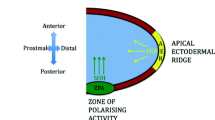Abstract
Background
Congenital absent digits continue to be described by many confusing terms and are currently classified in categories I, V, and VI of the International Federation of Societies for Surgery of the Hand classification and seven subclassification systems. Very few classification systems provide any logical basis for surgical reconstruction. The purpose of this study was to develop a simple alphanumerical documentation system to reproducibly describe the morphological or radiographic appearance of congenital absent digits and facilitate communication of these childrens’ hand anomalies from one hand surgeon to another.
Methods
Dorsal and palmar photographs and PA radiographs of 235 hands in 204 children born with congenital absent digits over a 15-year period were analyzed to determine which digital rays were missing and their level of absence. Each hand can be described by three letters, R (radial), C (central), and U (ulnar), as well as numbers 1–5. The first letter and number designate which rays are missing and the second and third letters and numbers designate which rays remain present.
Results
There are 15 morphological phenotypes of congenital absent digits. The three most common phenotypes are U4R1 (a thumb but absence of all four fingers), R1U4 (absent thumb), and R5 (aplastic hand).
Conclusions
This new documentation system allows hand surgeons to describe the simple morphological or radiographic appearance of congenital absent digits; incorporates all the previous subclassification systems that have attempted to describe congenital absent digits in radial, central, and ulnar deficiencies, symbrachydactyly, and congenital constriction ring syndrome; and has subsequently allowed the development of an algorithm which predicts whether conventional or microsurgical reconstruction is indicated for each specific phenotype.










Similar content being viewed by others
References
Barsky AJ. Cleft hand: classification, incidence, and treatment. Review of the literature and report of nineteen cases. J Bone Joint Surg Am. 1964;46:1707–20.
Bayne LG, Klug MS. Long-term review of the surgical treatment of radial deficiencies. J Hand Surg Am. 1987;12:169–79.
Blauth W. The hypoplastic thumb. Arch Orthop Unfallchir. 1967;62:225–46.
Blauth W, Gekeler J. Morphology and classification of symbrachydactylia. Handchirurgie. 1971;3:123–8.
Buck-Gramcko D. Cleft hands: classification and treatment. Hand Clin. 1985;1:467–73.
Buck-Gramcko D. Symbrachydactyly: a clinical entity. Tech Hand Up Extrem Surg. 1999;3:242–58.
Cheng JC, Chow SK, Leung PC. Classification of 578 cases of congenital upper limb anomalies with the IFSSH system—a 10years' experience. J Hand Surg Am. 1987;12:1055–60.
Cole RJ, Manske PR. Classification of ulnar deficiency according to the thumb and first web. J Hand Surg Am. 1997;22:479–88.
De Smet L. Classification for congenital anomalies of the hand: the IFSSH classification and the JSSH modification. Genet Couns. 2002;13:331–8.
Ekblom AG, Laurell T, Arner M. Epidemiology of congenital upper limb anomalies in 562 children born in 1997 to 2007: a total population study from stockholm, sweden. J Hand Surg Am. 2010;35:1742–54.
Flatt AE. A test of a classification of congenital anomalies of the upper extremity. Surg Clin North Am. 1970;50:509–16.
James MA, McCarroll Jr HR, Manske PR. The spectrum of radial longitudinal deficiency: a modified classification. J Hand Surg Am. 1999;24:1145–55.
Kallemeier PM, Manske PR, Davis B, et al. An assessment of the relationship between congenital transverse deficiency of the forearm and symbrachydactyly. J Hand Surg Am. 2007;32:1408–12.
Lamb DW, Wynne-Davies R, Soto L. An estimate of the population frequency of congenital malformations of the upper limb. J Hand Surg Am. 1982;7:557–62.
Maisels DO. Lobster-claw deformities of the hand. Hand. 1970;2:79–82.
Manske PR. Symbrachydactyly instead of atypical cleft hand. Plast Reconstr Surg. 1993;91:196.
Manske PR, Halikis MN. Surgical classification of central deficiency according to the thumb web. J Hand Surg Am. 1995;20:687–97.
Manske PR, Oberg KC. Classification and developmental biology of congenital anomalies of the hand and upper extremity. J Bone Joint Surg Am. 2009;91 Suppl 4:3–18.
Miller JK, Wenner SM, Kruger LM. Ulnar deficiency. J Hand Surg Am. 1986;11:822–9.
Miura T, Nakamura R, Horii E. The position of symbrachydactyly in the classification of congenital hand anomalies. J Hand Surg Br. 1994;19:350–4.
Nutt 3rd JN, Flatt AE. Congenital central hand deficit. J Hand Surg Am. 1981;6:48–60.
Ogino T. Teratogenic relationship between polydactyly, syndactyly and cleft hand. J Hand Surg Br. 1990;15:201–9.
Ogino T. Cleft hand Hand Clin. 1990;6:661–71.
Ogino T, Kato H. Clinical and experimental studies on ulnar ray deficiency. Handchir Mikrochir Plast Chir. 1988;20:330–7.
Ogino T, Minami A, Fukuda K, et al. Congenital anomalies of the upper limb among the Japanese in Sapporo. J Hand Surg Br. 1986;11:364–71.
Ogino T, Minami A, Kato H. Clinical features and roentgenograms of symbrachydactyly. J Hand Surg Br. 1989;14:303–6.
Patterson TJ. Congenital ring-constrictions. Br J Plast Surg. 1961;14:1–31.
Swanson AB. A classification for congenital limb malformations. J Hand Surg Am. 1976;1:8–22.
Swanson AB, Tada K, Yonenobu K. Ulnar ray deficiency: its various manifestations. J Hand Surg Am. 1984;9:658–64.
Tada K, Yonenobu K, Swanson AB. Congenital central ray deficiency in the hand- a survey of 59 cases and subclassification. J Hand Surg Am. 1981;6:434–41.
Tonkin MA. Description of congenital hand anomalies: a personal view. J Hand Surg Br. 2006;31:489–97.
Watari S, Tsuge K. A classification of cleft hands, based on clinical findings: theory of developmental mechanism. Plast Reconstr Surg. 1979;64:381–9.
Yamauchi Y, Tanabu S. Symbrachydactyly. In: Buck-Gramcko D, editor. Congenital malformations of the hand and forearm. Philadelphia: Churchill Livingstone; 1998. p. 149-158.
Conflict of interest
The authors declare that they have no conflicts of interest, commercial associations, or intent of financial gain regarding this research.
Author information
Authors and Affiliations
Corresponding author
About this article
Cite this article
Jones, N.F., Kaplan, J. A new documentation system for congenital absent digits. HAND 7, 391–399 (2012). https://doi.org/10.1007/s11552-012-9450-0
Published:
Issue Date:
DOI: https://doi.org/10.1007/s11552-012-9450-0




